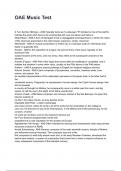OAE Music Test
A Turn Symbol (Strings) - ANS-Typically looks as if a sideways "S" dictated on top of the staff to
indicate the given pitch have to be ornamented with now not above and below it.
Alberti Bass - ANS-A form of damaged chord or arpeggiated accompaniment, in which the notes
of the chord are presented in the order lowest, maximum, center, maximum.
Allemande - ANS-A musical composition or motion (as in a baroque suite) in mild tempo and
duple or quadruple time.
Answer - ANS-In the exposition of a fugue, the second entry of the issue, typically on the
dominant if the
subject became at the tonic, and vice versa. Also refers to the subsequent answers to the
situation.
Answer (Fugue) - ANS-Part of the fugue that comes after the challenge is completed, and is
imitates the situation in some other voice, usually on the P5th above or the P4th below.
Anthem - ANS-A polyphonic sacred paintings in English for Anglican religious services.
Antonin Dvorak - ANS-Czech composer of symphonies, concertos, chamber works, tone
poems, and operas, he's
an excellent representative of the nationalism pervasive in European track in the latter half of
the
nineteenth-century. Poignantly, he represented a human beings- the Czech human beings- that
did not possess
a country all through his lifetime; he consequently once in a while used his music, and big
repute, to call the eye to the plight of his fellow countrymen.
Antonio Vivaldi - ANS-Italian composer and virtuoso violinist of the late Baroque. He spent the
full-size majority of
his life in his native Venice, as tune director at the
Ospedale della Piete - a lady's orphanage
and music school- where he wrote a lot of his works for the ensembles on the college to
carry out. He become by way of far most famous, in his lifetime and to this present day, for his
concerti, of which
he wrote six hundred, such as his maximum famous set,
the Four Seasons-programmatic works that
propelled him to vast reputation for the duration of Europe.
Appalachian Folk Songs - ANS-Often intended for dancing and characteristic clean easy phrase
structures inclusive of ABAB.
Arnold Schoenberg - ANS-German composer of the early twentieth century, disciple of Mahler,
and influential musical innovator. This composer was one of the
first composers to write fully atonal music and, in the early Nineteen Twenties, developed the
twelve-tone method- a system of composition that turned into to exert a massive influence on
many subsequent composers of the twentieth century.
, Arpeggiation - ANS-Refers to the sounding of notes of a chord one after every other melodically
in preference to concurrently.
Asymmetrical Period - ANS-There is an uneven wide variety of antecedents and conseequents.
Bard - ANS-Medieval poet-singer, specifically of epics.
Baroque Period - ANS-Period of tune history from about 1600 to about 1750, overlapping the
past due renaissance and
early classic duration.
Basso Continuo - ANS-System of notation and overall performance practice, used in the
Baroque length, in which an
instrumental bass line is written out and one or more players of keyboard, lute, or comparable
gadgets fill inside the concord with suitable chords or improvised melodic lines.
Bebop - ANS-A sort of jazz originating in the Nineteen Forties and characterised by using
complicated concord and rhythms.
Bela Bartok - ANS-Hungarian composer of the early twentieth century, he
changed into, like his present day Stravinsky, an influential musical innovator. Writing piano
tune, concerti, and, perhaps most extensively, string quartets, Bartok's song frequently included
the folk song of his local united states of america inside a compositional language that was
progressive harmonically and officially.
Block Chords - ANS-A chord or voicing built without delay below the melody both at the strong
beats or to create a four-component harmonized melody line in locked-hands rhythmic unison
with the melody, as opposed to damaged chords.
Blues Scale - ANS-A musical scale consisting of 1, flat3, 4, sharp4, five, and a flat7.
Cadences - ANS-Authentic: V-I
Plagal: IV-I
Half: End on V
Deceptive: V-IV
Cadenza - ANS-A virtuoso solo passage all through the Classical Era inserted into a motion in a
concerto or other work, typically near the end.
Canon - ANS-Composition in which the voices input successively at decided pitch and time
intervals, all
acting the same melody
Cantata - ANS-A medium-duration narrative piece of song for voices with instrumental
accompaniment, generally with solos, chorus, and orchestra.
Cantata - ANS-Form of Lutheran church music within the eighteenth century, combining poetic
texts with texts
drawn from chorales or the Bible, and consisting of recitatives, arias, chorale settings, and
commonly one or more choruses. In later eras, a work for soloists, chorus, and orchestra in
numerous movements however smaller than an oratorio.
Cantus Firmus - ANS-An existing melody, often taken from Gregorian Chant, on which new
polyphonic work is based totally.
Carl Maria von Weber - ANS-German composer of the early Romantic period superb for his
position in setting up of a clearly
German operatic fashion. His works are often innovative harmonically and orchestrationally- in
specific his opera Der Freischütz (T




